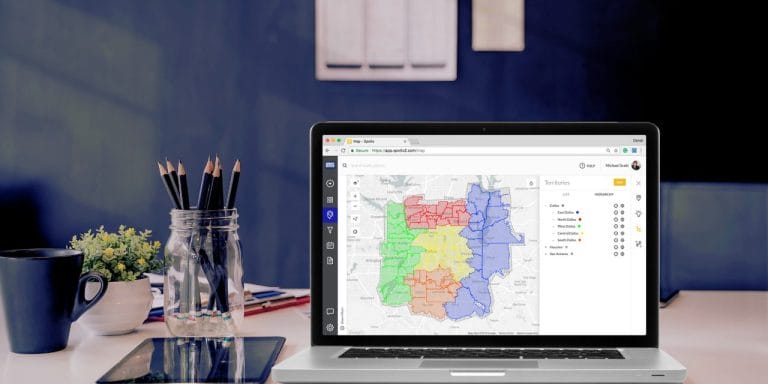Sales success isn’t just about working harder. It’s about working smarter.
The top 30% of sales reps outperform their peers by up to four times. The secret to their success often lies in how they use data. With sales analytics tools, these high performers gain insights that guide every decision, from prioritizing leads to closing deals faster. By adopting the same approach, your team can unlock new levels of efficiency and revenue growth.
What is Sales Analytics?
Sales analytics is the process of collecting, analyzing, and interpreting sales data to uncover actionable insights that improve decision-making and performance. It transforms raw data—such as customer interactions, sales trends, and team metrics—into meaningful patterns that help businesses optimize strategies and drive revenue growth.
The value of sales analytics lies in its ability to provide clarity in a competitive market. By analyzing historical and real-time data, businesses can identify trends, predict outcomes, and make informed decisions. For example, it can reveal which territories generate the highest close rates or which customer segments are most likely to respond to specific offers. These insights help teams allocate resources effectively, prioritize leads, and tailor their approach to meet customer needs.
Sales analytics tools enhance this process with automated data collection and real-time dashboards. Field reps can access customer insights on the go or adjust strategies instantly. Managers can track metrics like conversion rates or sales cycle length to identify areas for improvement.
Ultimately, sales analytics drives smarter strategies and sustainable growth by ensuring every decision is backed by data. For field sales teams, it’s an essential tool for staying agile, competitive, and focused on results.
Benefits of Using Sales Analytics Tools
Sales analytics tools have revolutionized how businesses approach sales performance by turning raw data into actionable insights. These tools go beyond simply collecting information: they analyze patterns, uncover trends, and provide clear guidance to improve decision-making and streamline processes.
By leveraging these insights, sales teams can focus on strategies that work, eliminate inefficiencies, and consistently hit their targets. Here are 5 benefits of using sales analytics software, and how they transform your team’s performance:
Smarter Sales Planning and Forecasting
Accurate planning is foundational for any sales team. By analyzing historical and real-time data, sales analytics tools enable precise forecasting. This allows field teams to:
- Prioritize high-value leads.
- Schedule activities based on customer behavior patterns.
- Anticipate market trends to stay ahead of competitors.
For example, a team using predictive analytics can identify seasonal demand spikes and allocate resources accordingly, ensuring maximum returns during peak periods.
Enhanced Team Performance Tracking
Tracking performance is critical for maintaining a productive team. Sales analytics tools provide managers with clear metrics such as:
- Conversion rates.
- Average deal size.
- Sales cycle length.
By setting data-backed KPIs, managers can evaluate individual contributions and overall team effectiveness. These insights also help identify coaching opportunities to improve underperforming reps while fostering healthy competition within the team.
Better Customer Understanding
Understanding customers is at the heart of successful selling. Sales analytics tools analyze customer behavior, preferences, and purchase history to provide a 360-degree view of your audience.
This enables you to:
- Anticipate customer needs before they arise, through behavior and purchase trends.
- Segment customers for tailored pitches.
- Build stronger relationships through personalized interactions.
For instance, by identifying which products resonate most with specific customer segments, your team can create targeted campaigns that drive conversions.
Territory Optimization and Route Planning
Efficient territory management can significantly impact a field sales team’s success. Sales analytics tools use location-based sales data to:
- Optimize territories for balanced workloads.
- Plan routes that minimize travel time while maximizing customer visits.
- Identify underserved areas with potential growth opportunities.
These capabilities ensure that your team spends less time on the road and more time engaging with prospects.
Real-Time Insights for On-the-Go Decisions
In fast-paced field sales environments, access to real-time data is crucial. Mobile-friendly dashboards allow reps to:
Adjust strategies in the field based on up-to-date information.
Respond quickly to changing customer needs.
Reallocate resources mid-day for maximum efficiency.
For example, if a rep notices that a key prospect has shown increased interest in a product via CRM activity logs, they can prioritize an immediate follow-up visit or call.
How to Use Sales Analytics Tools to Boost Sales
Using sales analytics tools effectively requires you to set clear goals, use the right tools, train your team, and review and refine your strategy. To fully harness the power of sales analytics tools, follow these steps:
1. Define Sales Goals and Targets
Start by reviewing historical data to set realistic yet ambitious goals. Key metrics to consider include conversion rates, average deal size, and pipeline velocity. For example, if your average deal size has been $10,000 but shows potential for growth in certain segments, set a target that challenges your team while remaining achievable.
2. Determine Your KPIs
Identify measurable KPIs that align with your goals. Monitoring these metrics ensures accountability and continuous improvement.
Here are some of the most impactful KPIs to track for field sales teams:
- Lead Response Time: The average time it takes for a sales rep to follow up with a new lead. Faster response times often lead to higher conversion rates.
- Number of Daily Customer Interactions: Tracks how many meaningful touchpoints (meetings, calls, or emails) a rep has with prospects or customers each day.
- Conversion Rate: The percentage of leads or opportunities that result in closed deals. This metric highlights the effectiveness of your team’s selling strategies.
- Sales Cycle Length: Measures the average time it takes to move a prospect from initial contact to closing a deal. Shorter cycles typically indicate more efficient processes.
- Pipeline Value: The total monetary value of all deals currently in the pipeline. This helps gauge whether your team is on track to meet revenue targets.
- Win Rate: The percentage of deals closed compared to the total number of opportunities pursued. A higher win rate indicates strong sales effectiveness.
- Territory Coverage: Tracks how effectively reps are managing their assigned territories, including the number of visits or interactions within specific regions.
- Upsell and Cross-Sell Metrics: Measures the percentage of customers who purchase additional products or services beyond their initial transaction.
By focusing on these critical KPIs, you can create a data-driven culture that empowers your field sales team to perform at their best while ensuring alignment with your company’s goals.
3. Choose the Best Sales Analytics Tool
Choosing the best sales analytics tool for your needs is critical for empowering your team and driving results. The right tool can streamline processes, provide actionable insights, and help your team close more deals. Here are key factors to consider:
- Ease of Use: A sales analytics tool should be intuitive and easy for all team members to adopt, regardless of their technical expertise. A user-friendly interface ensures that your team can quickly navigate the platform and start leveraging its features without frustration.
- CRM Integration: Seamless integration with your existing CRM system is essential. The tool should work in harmony with your current workflows, eliminating the need for manual data transfers while providing a unified view of your sales pipeline.
- Mobile Accessibility: For field sales teams, mobile-friendly dashboards are a must. Reps need access to real-time data while on the go, enabling them to make informed decisions during client meetings or adjust their strategies as needed.
- Advanced Reporting Capabilities: Look for tools that offer customizable reports and visualizations, such as charts or heatmaps. These features make it easy to identify trends and patterns in your data, helping you refine strategies over time.
Additionally, consider the following when evaluating options:
- Scalability: Ensure the tool can grow with your business. As your team expands or your data needs increase, the platform should be able to handle larger volumes of information without compromising performance.
- Pricing: Choose a solution that fits within your budget while offering the features you need. Evaluate what’s included to ensure you’re getting value for your investment.
- Vendor Support: Reliable customer support is crucial. Look for vendors that provide onboarding assistance, training resources, and ongoing technical support to help your team maximize the tool’s potential.
By focusing on these factors, you’ll select the best sales analytics software to drive smarter decision-making across every stage of the sales process.
4. Train and Empower Your Team
Provide hands-on training to ensure your team understands how to use sales analytics tools effectively. Training should focus on both the technical aspects of the tools and how they apply to real-world sales scenarios. For example, demonstrate how to interpret data visualizations or use predictive insights to prioritize leads. This practical approach helps team members feel confident in applying the tools to their daily workflows.
Continuous support is equally important, especially as new features are introduced or processes evolve. Regular check-ins, refresher sessions, and access to updated resources ensure your team stays proficient and engaged. By fostering a culture of learning and adaptability, you empower your sales reps to fully leverage the tools, stay ahead of competitors, and consistently achieve their goals.
5. Gather and Analyze Your Data
Collecting customer data consistently across all touchpoints is essential for gaining real-time insights and achieving your sales goals. Real-time data visualizations, such as charts or heatmaps, make it easier to identify trends and patterns in your sales operations.
For example, if certain territories show higher close rates during specific times of the year, you can adjust your strategy accordingly to maximize results. By leveraging these insights, your team can make informed decisions that drive success.
6. Regularly Review and Adjust Strategies
To achieve consistent sales growth, it’s essential to regularly review and refine your strategies. Sales analytics tools allow you to test different scenarios, monitor results, and make data-driven adjustments that improve outcomes over time. Here’s how to approach this process effectively:
- Test Different Scenarios: Use the data you gather to experiment with various approaches. For example, try targeting different customer segments, adjusting pricing strategies, or focusing on specific territories. Testing allows you to identify what works best for your team and customers.
- Monitor Results Closely: Track key metrics such as conversion rates, sales cycle length, and deal size to measure the impact of your changes. Look for patterns in the data that reveal opportunities for improvement or highlight areas where your strategy may need adjustment.
- Identify Trends and Patterns: Sales analytics tools can help you uncover trends that might not be immediately obvious. For instance, you may notice that certain products perform better during specific times of the year or that particular customer segments respond more positively to tailored messaging.
Once you’ve gathered insights from your tests and monitoring efforts, take action:
- Refine Your Approach: Use the insights to fine-tune your strategies. If you find that a specific sales pitch resonates with a particular audience, standardize it across your team. Similarly, if certain territories underperform, consider reallocating resources or adjusting your approach in those areas.
- Adapt to Market Changes: The sales landscape is constantly evolving due to factors like seasonality, economic shifts, or competitor activity. Regularly reviewing your data ensures you’re agile enough to adapt quickly and stay ahead of the competition.
- Set New Goals: As you refine your strategies, use the data to set updated goals for your team. These goals should reflect the insights you’ve gained and push your team toward continuous improvement.
By making regular reviews a priority, you can ensure that your sales strategies remain effective and aligned with your goals. This process not only helps you stay competitive but also fosters a culture of adaptability within your team—one that thrives on data-driven decision-making and constant improvement.
Get Data-Driven Sales with SPOTIO
Sales analytics tools are revolutionizing how field sales teams operate by improving planning, tracking performance, understanding customers better, and optimizing resources. SPOTIO’s solutions are designed specifically for field sales professionals who want actionable insights at their fingertips.
With SPOTIO’s advanced features—like route optimization, mobile-friendly dashboards, and real-time reporting—you can empower your team to achieve greater efficiency and drive revenue growth like never before. To explore whether SPOTIO is the best sales analytics tool for your needs, request a demo today.
Or, to gain even deeper insights into the state of field sales and how analytics can transform your strategy, download your free copy of SPOTIO’s 5th Annual State of Field Sales Report.




